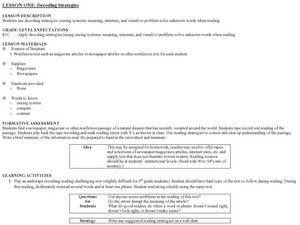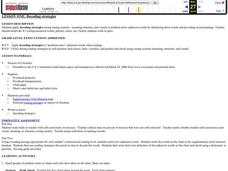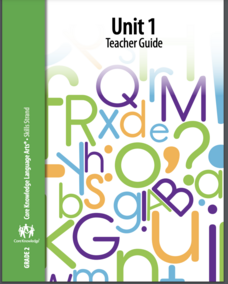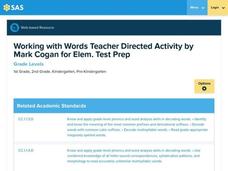Meadows Center for Preventing Educational Risk, University of Texas at Austin
Lesson 13 - Multisyllabic Word Reading
One- and two-syllable words may flow from the tongue with ease, but longer words, such as department and volcano, feel like tongue twisters. Scaffolded instruction explains how to break words into their individual syllables, and then...
Curated OER
Word Origins
Understanding a word's etymology can really help with decoding and building vocabulary skills. Readers compare and contrast words of similar origins but with different difficulty levels. They focus on prefixes, suffixes, and affixes....
Florida Center for Reading Research
Fluency: Words, Quick Sort
Peers work together to boost fluency by timing each other as they read and sort multisyllabic words. Record sheets keep track of participants' progress.
Curated OER
Lesson One: Decoding Strategies
Review decoding strategies to read a chosen text. Readers tape themselves reading out loud, listen to the recording, and mark where they have misread words or phrases. They then discuss which words were misread and review how to correct...
Curated OER
Word Review Card Activity
Pupils play a card game where they match the meaning of the word to the word or its prefix/suffix. They listen for the teacher to call out the definition and, with two players facing off, the first one to slap the correct card wins! Kids...
Curated OER
Affix This
Wait, what am I supposed to affix? Explore the concept of roots/affixes with your class. They use discussion questions to discover the meaning and usage of specific roots and affixes. They watch a video explaining Latin and Greek roots...
Curated OER
Decoding Strategies
Young readers apply decoding strategies to identify unknown words. In this reading instructional activity, they read the Preamble and practice using decoding strategies. Small groups rotate to five charts that have questions regarding...
Curated OER
Applying Decoding, Vocabulary, and During Reading Strategies
Apply reading strategies to boost phonemic awareness. While reading a provided informational text, learners use decoding, vocabulary, and a graphic organizer to strengthen their overall reading ability. Handouts and the reading passage...
Curated OER
Vocabulary through Text
Explore word meanings. Sixth graders identify examples of words with affixes while listening to the story Paul Bunyan by Steven Kellogg. They participate in the game "Pass the Parts" and practice separating given words into their root...
Curated OER
Take the Prefix Challenge
Students form words using prefixes. In this prefix lesson, students compete in a "prefix challenge" to see which team can combine a set of twelve prefixes with a set of twelve words fastest. Students enter their words in a word log and...
National Institute for Literacy
Making Sense of Decoding and Spelling
Go over digraphs, vowel sounds, and affixes with a series of decoding and spelling lessons. Each lesson guides learners through a different reading and phonics skill, building on the lesson before, and challenging them with each step.
Core Knowledge Foundation
Second Grade Skills Unit 5: Sir Gus
A unit focuses on second-grade skills, specifically spelling, grammar, writing, and reading. Over six weeks, scholars review spelling patterns and tricky words, and explore verb tenses, adjectives, subjects, and predicates. They write...
Meadows Center for Preventing Educational Risk, University of Texas at Austin
Lesson 14 - Consonant-Le Syllables
The consonant-le syllable may appear in the word idle, but it is anything but dull. An informative lesson plan introduces words containing the consonant-le syllable. Using guided instruction, learners discover how to break words...
Core Knowledge Foundation
Second Grade Skills Unit 4: The Job Hunt
Second graders practice skills, including spelling, grammar, and reading. Pupils examine vowel sounds and tricky words, nouns, and verbs. They begin the writing process by drafting a persuasive letter and decoding texts.
Core Knowledge Foundation
Second Grade Skills Unit 1: The Cat Bandit
For twenty-two lessons over five weeks, scholars practice sound-spelling correspondence, spelling patterns, tricky words, and reading decodable text. Assessments aid in small group formation and gauge comprehension. Lessons begin with a...
Pennsylvania Department of Education
Working with Words Teacher Directed Activity by Mark Cogan for Elem. Test Prep
Pupils build word families. In this interactive language arts activity, students visit a website where they play a game creating word families. Pupils may print out their work when finished.
Book Units Teacher
Skill Lessons – Prefixes and Suffixes
Sometimes the best way to understand a concept is to break it down. Young vocabulary pupils work with word parts in a hands-on activity that prompts them to connect flash cards with affixes to their root and base words. Additionally,...
Curated OER
Alphabet
Students state the letters of the alphabet individually and in new words. In this alphabet lesson plan, students use the alphabet in a variety of ways during reading.
Pennsylvania Department of Education
Pictures and Print: What's the Difference?
Learners watch a PowerPoint presentation. For this early literacy lesson, students watch a PowerPoint presentation describing print from pictures and the difference between the two.




















